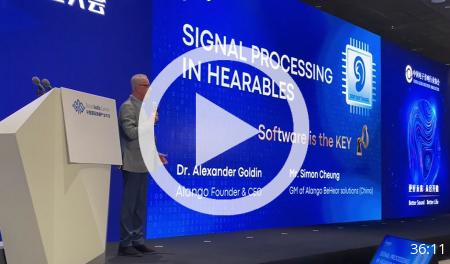|
|
 |
|
Approximately 600 million people in the world have a hearing impairment. What’s more, 90% of hearing impaired people do not use a Hearing Enhancement device. These people know about hearing aids but have decided not to use them due to cost, convenience, perception, or efficacy – all legitimate concerns. What if treating a hearing impairment was more like the experience of treating poor eyesight like buying glasses? In other words, “Glasses for the Hearing Impaired”. This would be a welcome development for the hearing impaired individual. Alango envisions convenient and inexpensive access to Hearing Enhancement solutions. The perception about how one appears while wearing a hearing aid is typically not positive. The actual experience of obtaining a hearing aid can be frustrating. Dealing with added cost distribution layers and multiple fitting/tuning sessions at an audiologist’s office are among these frustrations. Sometimes the end result is a high cost device that does not work well. This is not to say that there aren’t satisfied hearing aid users. There are. But there is another way. We believe that the future belongs to hearing enhancement devices that are as easy to choose, personalize and buy as ordinary glasses. These devices will provide a solution to millions of hard of hearing people around the world. Alango is at the forefront of the consumerization of Hearing Enhancement. Alango has developed a licensable software reference design called Hearing Enhancement Package (HEP)™. The HEP solution allows Hearing Enhancement and Assistive Listening functionality to be included in one low cost consumer grade device. With Assistive Listening this device can be paired with a Bluetooth transmitter to transmit TV audio to avoid excessively raising the TV volume. Another Assistive Listening application is the pairing of a Bluetooth microphone with the device for transmission of audio in a conference or presentation. Finally, Assistive Listening allows two HEP-enabled devices to be paired and used as Bluetooth intercoms. But there's more. Beyond Hearing Enhancement and Assistive Listening, a range of technologies is accessible to craft a fully-featured Bluetooth headset with advanced functionality. This includes Alango's proprietary AVQ-Me™, SonicVibrance™, and EasyListen™ technologies. Classical DSP-based dereverberation, as manifested in our present-generation voice communication solutions – VCP and eVCP, stands out as a robust and proven technique for diminishing the effects of reverberation. However, when room reverberation time becomes long, this classical audio signal processing approach does come with inherent limitations due to their inability to differentiate between consecutive phonemes when they are smeared by the reverberation and overlap with each other. Classical algorithms will consider such merged phones as either one entity and not clean it or as noise and suppress it. To effectively counter long-lasting reverberation, we have developed a Deep Learning Neural Network Dereverberation algorithm. To be practical, we limited ourselves to a relatively small, convolutional network that can easily run on low cost, low power MCU, MPU or DSP. This technology utilizes a single microphone and can be incorporated as part of our package or used independently if the developer chooses to implement it alongside their existing voice processing. In the section below, we provide audio examples showcasing the performance of our prototype deep learning dereverberation algorithm.
|
| Adaptive Directional Microphone (ADM) |
Acoustic beamforming utilizes two or more microphones to emphasize sounds coming from the front and helps to discriminate between speech and noise. |
|||
| Feedback Canceller (FC) |
Eliminates howling and whistling caused by the speaker output feeding back into the microphones. |
|||
| Binaural Sound Enhancement |
Coordinates between left and right ears processing ensuring spatial and directional information to be preserved. This allows natural sound localization also improving intelligibility in noisy conditions. |
|||
| Noise Suppressor (NS) |
Detects and attenuates stationary and transient noises (street, pub, etc.) in the microphone signal. |
|||
| Multi-channel Dynamic Range Compression |
This technology is the core of sound personalization and hearing enhancement. This technology dynamically modifies gains of specific frequency channels (bands) allowing to tune the device for an individual user preferences or hearing loss compensation. |
|||
| SonicVibrance™ |
Alango’s music enhancement technology that optimizes stereo, enhances weak spectral components, and applies bass and loudspeaker correction. |
|||
| EasyListen™ |
Slows down incoming speech in real time improving intelligibility of fast talkers, foreign language, mailbox and numbers. |
|||
| Automatic Volume & Equalization (AVQ) |
Modifies the loudspeaker signal according to the ambient noise level and spectrum providing perceptually equal loudness and intelligibility in dynamically changing conditions (street, bus, train, etc.). |
|||
| Own Voice Attenuation | Patent pending technology for reliably detecting and attenuating the user’s own voice using a bone conduction voice vibration sensor. | |||
|
|
Precise Hearing Personalization
Without a Hearing Test |
Deep Learning for Better Hearing:
AI noise reduction in Hearing Aids |
|
|
Deep Learning for Better Hearing:
How AI can reduce Reverberation in Hearing Aids |
AI Helping People to Hear Better.
WAIC 2023 |
|
|
Digital Sound Processing in Hearables. With short explanations in Chinese by Simon Cheung
|
|
(Marketing presentation. PDF)
|






